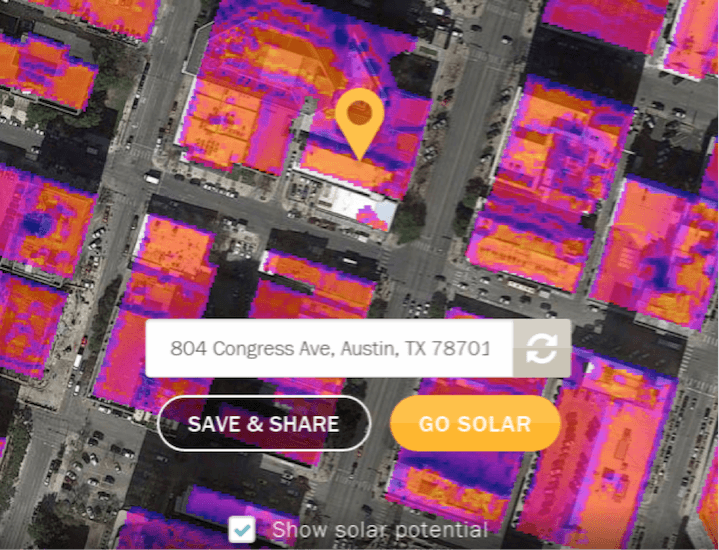
By Erin Vaughan
Switching to solar energy can feel a lot like tunneling into the unknown. Reliable data — and the kind of slick Web presence that goes along with it — is difficult to find, to say the least. Homeowners often find themselves jockeying between dense government databases and Doomsday preppers’ blogs in their quest to seek out real, fact-based information about their actual solar energy costs, energy potential, and savings.
This might explain why only one out of six energy consumers understands their renewable energy options, according to a survey performed by Natural Marketing Institute — despite the fact that 80 percent of participants demonstrated an interest in energy alternatives. The problem comes into sharp relief when you consider the demographics of solar: Research from Accenture predicts that over twice as many millennials will switch to solar than will their boomer counterparts in the next five years. Millennials — digital natives, as they’re often described — are not only fluent with Web interfaces but consider social media and technology a means to positive change, whether environmental or personal. Considering that, it’s safe to say that the solar energy market could use a digital makeover.
But updating solar for a digital era is not without its challenges. For instance, there’s the sheer volume of data: Actual costs and savings for solar-energy systems depend on a wide range of factors that include anything from what kind of rebates your provider offers to how often you run your dryer. So, obtaining anything beyond a rough estimate of energy consumption and expenses can be difficult. Geography provides another obstacle: homeowners have to consider not only their area’s general climate but also the slope and orientation of their home’s roof. And these kinds of slight, individual differences can have a big impact. For instance, EnergySage found that a roof tilt of five degrees could reduce energy production by over 10 percent.
Digital tools need to tailor their experience to their user
Consumers have grown accustomed to tools that personalize their experience — the way retail sites consider past purchases, and Google maps factors in a phone’s geolocation — in an attempt to present the most relevant products and services. So, why should solar be any different?When we designed Modernize’s ModSun tool, we wanted to give users real insight into their home’s actual location, their roof orientation and slope, as well as their area’s energy costs, by allowing them to search a mapped database using their home address. We agreed that the experience should mimic the kind of customized visual homeowners might get if they searched their address in Google Earth, as a way to see the energy potential for their precise location.
To give users a satisfactory, fact-driven experience, we leveraged variables from Geostellar’s Light Detection and Ranging (LIDAR) data. That cuts out a big barrier to solar: Previously, a homeowner would need to have a professional come by with a GPS to get accurate production estimates. ModSun runs on technology Geostellar patented with support from the Department of Energy’s SunShot Initiative, which helps us express surface light and heat variables for over 70 million roofs across the U.S. — and calculate those rates back into a formula to lay out a home’s real solar potential.
Streamlined tools make their use seamless
Solar incentives, designed to encourage homeowners to switch to alternative energy, may actually have the opposite effect when not properly articulated. For instance, DSIRE, one of the most comprehensive databases for renewable energy programs, lists over 178 entries for California residents and businesses alone. While undoubtedly a great resource, sorting through those pages (complete with their bulky, bureaucratic language) is intimidating for homeowners, to say the least.And that’s a major problem for those of us in solar. The price point of many systems amounts to well over the cost of your average car when you add in installation fees. Even though solar panel prices have fallen at nearly record levels, the average reported cost still hangs at around $20,000. It’s asking a lot from homeowners to swallow the full expense without some relief. Incentives offer just that: potentially thousands of dollars shaved off the initial purchase. But without an intuitive interface, how can solar households take advantage of those cost-mitigating savings without a burdensome time commitment?
One of our major goals with ModSun was to provide users with a “snapshot” of their real-dollar annual savings after incentive programs were factored in — that way, homeowners could understand, at a glance, the actual dollar worth of these programs. Additionally, we tried to factor in alternative pricing plans like leases and PPAs so that we could reach users in a wide range of economic circumstances. To further a user’s understanding of their solar savings, we find their area’s average utility spendings — and allow them to see a quick cost-benefit analysis. Then, the whole thing can be saved as a profile or emailed to make sharing simple.
The solar space grew by leaps and bounds this year — and it’s set to expand to at least six times its current size in the next 14 years if estimates from Bloomberg are to be believed. With upward momentum like that and a young public primed for alternative energy, the only thing standing in solar’s way is itself.
Images courtesy of Modernize
Erin Vaughan is a blogger, gardener and aspiring homeowner. She currently resides in Austin, TX where she writes full time for Modernize.com, with the goal of empowering homeowners with the expert guidance and educational tools they need to take on big home projects with confidence.
TriplePundit has published articles from over 1000 contributors. If you'd like to be a guest author, please get in touch!














